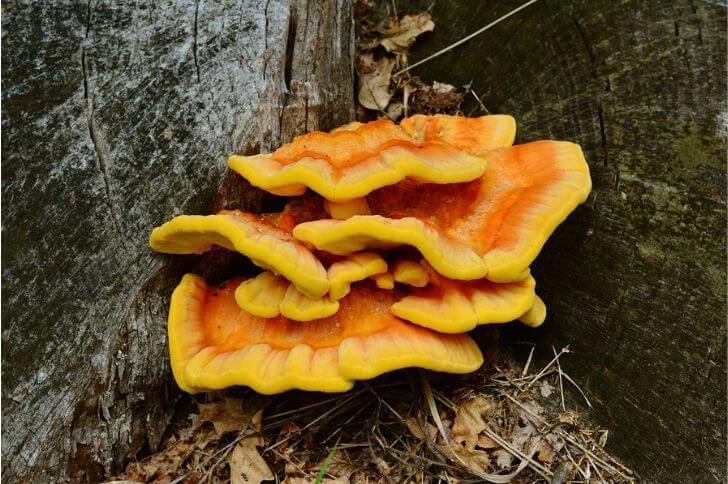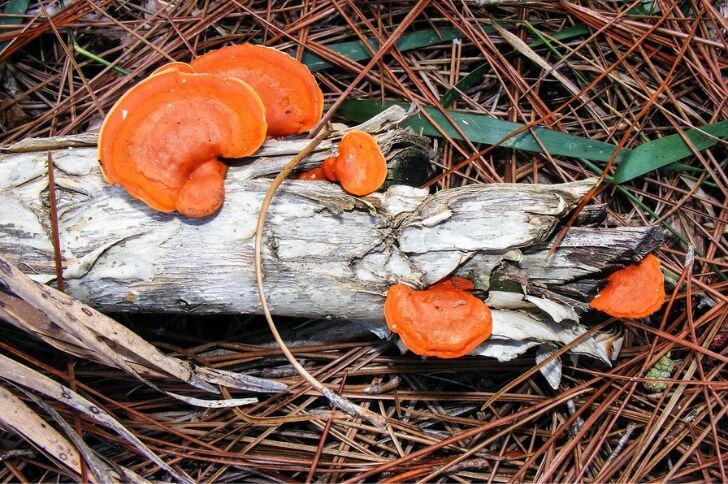Orange shelf mushrooms are a fascinating and diverse group of fungi that can be found adorning the bark of trees, fallen logs, and even decaying stumps.
Their vibrant orange hue and distinctive shelf-like growth pattern make them a striking sight in the forest, capturing the imagination of nature enthusiasts and mycologists alike.
With their varied sizes, and ecological roles, exploring the types of orange bracket mushrooms promises to unveil a world of wonder and intrigue lurking just beneath the surface of our wooded landscapes.
From the eye-catching beauty of the chicken-of-the-woods to the intricate structures of the cinnabar polypore each type offers its own unique characteristics that contribute to its allure.
Orange shelf mushrooms
1. Sulphur Shelf Mushrooms

Sulphur shelf mushrooms are a vibrant and eye-catching addition to any forest landscape. Their bright orange to yellow coloration is a visual treat for nature enthusiasts and foragers alike.
What’s truly fascinating about chicken of the woods is their ability to grow in large, conspicuous clusters on the trunks of trees, creating a stunning display that’s hard to miss.
As an edible mushroom with a meaty texture, they offer an exciting culinary experience for those brave enough to harvest them.
What sets these orange shelf mushrooms apart from other fungi is their unique role in nature as decomposers of wood.
They can often be found growing on dead or dying trees, participating in the crucial process of breaking down organic matter and returning nutrients to the soil.
This symbiotic relationship with their environment not only highlights their ecological importance but also showcases their resilience and adaptability in diverse ecosystems.
With such an interesting blend of visual appeal, culinary potential, and ecological significance, it’s no wonder that sulphur shelf mushrooms continue to captivate both seasoned foragers and casual admirers alike.
2. Cinnabar Polypore

The cinnabar polypore, also known as Pycnoporus cinnabarinus, is a strikingly vibrant member of the fungal world. Its bright orange-red caps and velvety texture make it a stunning addition to any forest landscape.
Interestingly, despite its eye-catching appearance, the cinnabar polypore is not just about looks—it plays a crucial role in nature’s ecosystem.
This fungus primarily grows on dead or dying trees, where it functions as a key player in the process of decomposition, breaking down organic matter and returning nutrients to the soil.
3. Phyllotopsis Nidulans
Phyllotopsis nidulans, commonly known as the orange oysterling or mock oyster, is a species of mushroom that captivates onlookers with its vibrant orange color and unique shelf-like appearance.
Found growing in clusters on decaying hardwood logs and stumps, these bracket mushrooms add a pop of color to the forest floor. Their striking hue serves as a beacon for curious foragers and nature enthusiasts alike, drawing attention to the intricate beauty of the natural world.
One fascinating aspect of the mock oyster is its ability to adapt and thrive in various environmental conditions. This adaptability allows the mushroom to play a crucial role in decomposing organic matter, contributing to the nutrient cycle within ecosystems.
4. Varnish Shelf Mushroom
The varnish shelf mushroom, also known as Ganoderma tsugae, is a strikingly beautiful and beneficial fungus that deserves our attention. Its glossy reddish-orange or brown cap and woody texture make it easily distinguishable from other shelf mushrooms.
The varnish shelf mushroom is inedible. However, in Asian culture it is often dried and used to make tea.
5. Phaeolus Schweinitzii
Phaeolus schweinitzii, commonly known as the dyer’s polypore, is a striking orange shelf mushroom that can be found adorning the trunks of various trees in temperate forests.
What sets this species apart is its remarkable ability to produce a vibrant yellow-orange dye that has been used for centuries by indigenous cultures and textile artists.
Beyond its aesthetic appeal, Phaeolus schweinitzii also exhibits fascinating ecological roles. Its mycelium forms symbiotic relationships with tree roots, aiding in nutrient absorption while also decomposing wood material and contributing to forest nutrient cycles.
6. Neofavolus Alveolaris
Neofavolus alveolaris, also called hexagonal-pored polypore, is a mesmerizing sight to behold in the wild. Its orange-brown hue and distinctive shelf-like structure make it a standout feature of fall forests.
These mushrooms often grow in clusters on decaying hardwood trees, adding a burst of color to the otherwise earthy tones of the forest floor.
What sets this bracket fungus apart from other mushrooms is its unique undercap texture, resembling intricate honeycomb patterns.
This distinguishing characteristic not only makes it visually striking but also plays a crucial role in its ecological function. The porous nature of the mushroom provides habitat for various microorganisms and insects, contributing to the intricate web of life within forest ecosystems.
7. Pycnoporellus Fulgens
Pycnoporellus fulgens is a stunning and unique fungi species that can be found growing on decaying wood in forests around the world. With its brownish-orange color and striking shelf-like appearance, this mushroom isn’t just a feast for the eyes – it also plays an important ecological role.
As a saprotrophic organism, Pycnoporellus fulgens feeds on dead wood, helping to break it down and recycle nutrients back into the ecosystem. Its presence in forest environments not only adds to the beauty of the landscape but also contributes to the natural process of decay and regeneration.
One fascinating aspect of Pycnoporellus fulgens is its symbiotic relationship with various plant species. This mushroom forms mycorrhizal associations with trees such as oaks and pines, exchanging nutrients with their roots in a mutually beneficial partnership.
This dynamic interaction highlights the intricate web of connections within forest ecosystems, showing us that life beneath our feet is just as vibrant and complex as what we see above ground. It’s a reminder that nature’s intricacies often lie beyond our immediate perception, waiting to be discovered by those who venture deeper into the woods.
Final Thoughts:
The diverse range of orange shelf mushrooms showcases the richness and variety of fungi in our natural world.
From the vibrant coloration to the unique textures, each type offers its own distinct appeal. Whether found on dead wood or living trees, these mushrooms play an important role in ecosystems and contribute to forest health.
As we continue to explore and study these fascinating organisms, it is essential to appreciate and protect their habitats. By learning more about the types of orange shelf mushrooms, we can deepen our understanding of the natural world and contribute to conservation efforts for these vital components of our environment.
Take a closer look at these remarkable fungi and discover the beauty and significance they hold within our forests.
sources:

